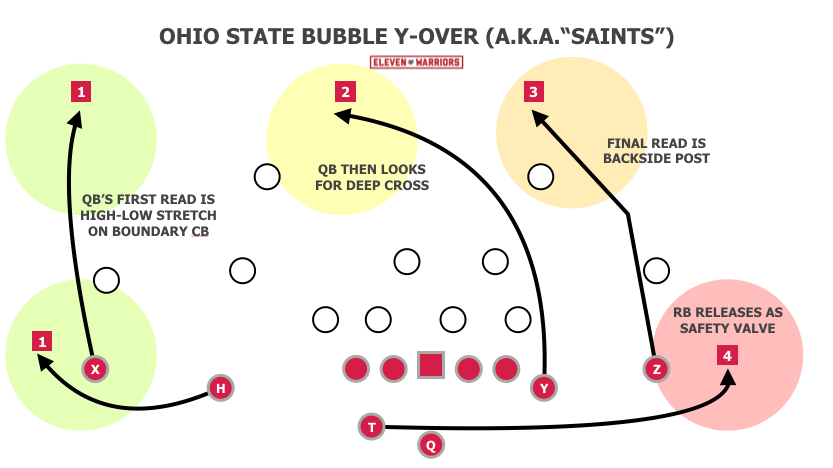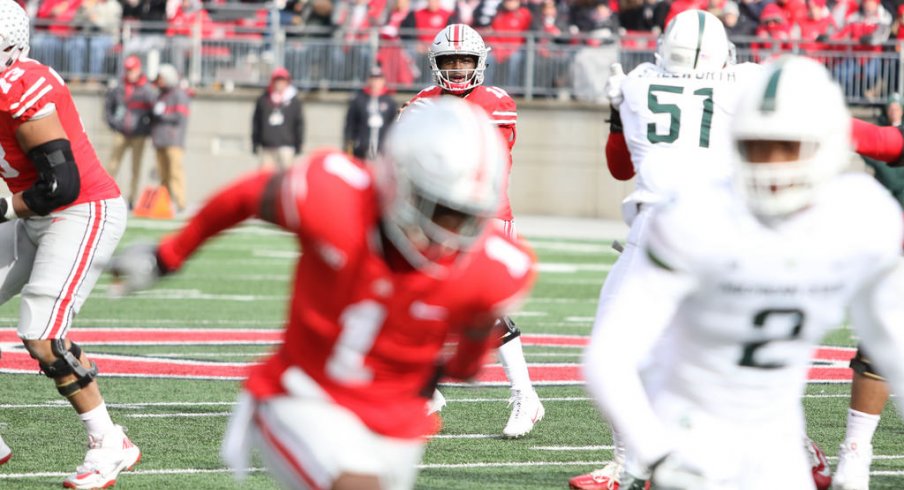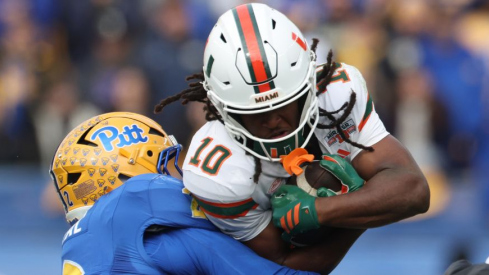After a career spent entirely on the coasts, Chip Kelly's influence may be felt most in the Midwest this fall.
As Ryan Day enters his second year in Columbus, the protege of the former Oregon, Philadelphia, and San Francisco head coach appears poised to further model the Buckeye offense after that of his college coordinator. Many Ohio State fans are surely aware of Day's connection to Kelly by now, as the current leader of UCLA's program first began breaking records two decades ago at the University of New Hampshire with Day under center.
But although Kelly is most famous for a time the two were apart - his six seasons leading the Ducks in Eugene - it's clear that Day has adopted many of his mentor's offensive philosophies and concepts as his own. Now, with more responsibility as the main play-caller for Urban Meyer's squad this fall, Buckeye fans should continue to see development in the passing game, even as a new quarterback takes the reins from J.T. Barrett.
Last fall, Day helped resuscitate a dismal aerial attack that finished 81st nationally in 2016, lifting its production all the way to 36th the following season despite losing the team's best receiver in Curtis Samuel. As a result, the OSU offense tallied 506 total yards-per-game in 2017, good for seventh nationally and a far cry from their 41st and 31st ranking the two years prior.
With the element of surprise now seemingly taken away from a coach who had never worked in the Big Ten prior to last year, Day faces the decision of doubling down on what he knows or trying something new entirely. Based on what we saw in last month's Scarlet & Gray game, it appears that he and fellow coordinator Kevin Wilson have opted for the former.
That April afternoon, both contenders for the quarterback job showed an ability to read the intermediate Mesh and Snag concepts that were seen so often in 2017. Though Snag is found in nearly every playbook across the country, Kelly's version of Mesh is unique, adding a wheel route from the running back and a middle hook route over the middle to draw the linebackers away from the dual crossing routes. As opponents began to look for the unique and successful concept, Day did an excellent job of disguising the play by running it from different formations and personnel groups, masking his tendencies while creating mismatches in the process.
| Year | 25+ Yd Pass Plays |
|---|---|
| 2012 | 20 |
| 2013 | 28 |
| 2014 | 42 |
| 2015 | 23 |
| 2016 | 23 |
| 2017 | 32 |
But the Mesh variant wasn't the only concept Day imported from Kelly's playbook. Last fall, the Buckeyes found some success throwing the deep ball for the first time since Devin Smith left for the NFL following the 2014 season, thanks in large part to Saints, Kelly's signature passing play.
Bubble Y-Over, as it's known in the playbook, pairs well with the Buckeye running game, where Wilson and Day often add a bubble screen to run calls, effectively creating three places where the ball can go on the play (RB handoff, QB keep, WR screen). With this threat of a screen ever-present, defenders responsible for defending it often cheat out of position after getting beat once or twice. So, by faking the handoff and running a bubble route, the defense believes they're in for another screen pass.
In reality, though, the other receiver to that side takes off on a deep, vertical route, creating a high-low stretch on the cornerback to that area, giving the passer an easy read: if the corner attacks the bubble, throw the vertical; if the corner stays on the vertical and no one comes up on the bubble, throw the bubble.

Against man-coverage and disciplined pattern-matching defenses, both routes rarely break open, however, as defensive coordinators hate few things more than getting beat on a fake screen. But Saints is based in part on the Air Raid Y-Cross concept, in which the #2 backside receiver runs a deep crossing route toward the boundary.
This deep crosser is the route that often flashes open if both patterns in the high-low read are covered, as the backside safety doesn't often expect a route to cross his face and overload the play-side with three receivers. Additionally, if the defense is in man, the receiver has a chance to simply out-run his defender, creating enough space to complete the pass.
Should the deep cross fail to flash open, though, the backside receiver trails behind it on a skinny post, often filling the space vacated by the defender chasing the deep cross (usually that backside safety). Both the cross and the post routes can be adjusted to find open grass, based on whether the defense is in man or zone, or 1-high or 2-high safety looks.
Finally, if none of these four routes come open or the QB runs out of time in the pocket, he can simply dump the ball off to the back in the flat after carrying out the fake handoff.
But while the play appears at first to be built on the premise of faking a bubble screen, in reality, it's a three-vertical concept with a receiver in either flat, stretching the defense both vertically down the field and horizontally from sideline-to-sideline. Regardless of what routes put a receiver in each of these spots, the quarterback's read doesn't change, making it a true concept and not just a collection of patterns.
In the Buckeyes' spring game, Day showed how this thinking is already being applied, as he and the other coaches installed multiple ways of creating the initial high-low stretch to the boundary.
Day hadn't waited until this spring to begin tinkering with different ways to run Saints, as he trotted out a tweaked version at the Big Ten Championship Game to face Wisconsin's Quarter-Quarter-Half coverage scheme. Knowing the Badgers would likely task three defenders with covering deep routes on every play, it would be tough to spring open any of the three deep routes the Buckeyes would send out in the basic version of the concept.
To counter, Day emptied the backfield and made the play a four-verticals concept, adding a second deep cross that would put the free safety in conflict, leaving them both open downfield.
But to find more variants of the play, Day need only go back to his days working with Kelly, as the former Eagles quarterback coach got to sit front and center as the play was tweaked week to week in order to create the personnel mismatches that define NFL strategy.
In one instance, Philadelphia created the high-low stretch by sending the tight end on an arrow route to the flat. In the example below, had the quarterback read this route combo longer, he would've found the tight end wide open instead of moving on to the cross so quickly.
Of course, one of the other big reasons Kelly's influence will be felt in the Big Ten is the hiring of another of his proteges, Scott Frost, as Nebraska's head coach. Frost spent four seasons coaching receivers at Oregon under Kelly, taking on coordinator duties once Kelly left for the NFL and Mark Helfrich moved up to the top chair.
When Frost left Eugene to lead the program at UCF, he brought the playbook with him, which included a number of ways to run Saints. As you can see below, what begins as a trips formation with only a tight end to the boundary becomes something quite different altogether once the ball is snapped.
The Z receiver goes in motion to create the 2x2 look often used to run the concept, but the routes themselves are quite different than the traditional Bubble Y-Over. The high-low stretch is created by a corner/out combo (sometimes called a Bench concept), but the motioned Z receiver actually becomes the middle crosser after lining up outside the tight end at the snap. This is often referred to as a switch or swap concept, as the two players trade responsibilities.
Most importantly, though, there are still three deep routes stretching the back end of the defense with a receiver in either flat stretching them horizontally. Though few of the routes match what was originally drawn up in the concept, it's still the same read for the QB.
Another way to break tendency is by tweaking the position of the back. Given that the tailback often comes across the QB for the fake handoff before releasing to the opposite flat on his pass route, defenses can guess which side will feature the initial high-low stretch and to which direction the crossers will be headed.
Additionally, the back appears to take the handoff on a lateral run like a sweep, which is rare in the Buckeye offense, potentially tipping off the defense. But back in Eugene, Kelly's staff adapted the concept to fit the same tight zone run that as is OSU's core rushing play, asking the back to cut outside after initially taking off inside.
Similarly, the Buckeyes can adapt the concept to other run plays that may not require the same mesh-style handoff that we've seen in every example thus far. One such play is the Power-Toss concept that is an evolution of the Power-Read play that has long been a staple of the OSU run game under Meyer.
As you can see below, the backside guard pulls in the direction of the back, giving the linebackers and safeties a false read in the opposite direction of the crossing routes, giving the receivers an extra step. Though the pass is ultimately incomplete, the defender was left on an island as the free safety got caught looking in the backfield and was nowhere near the play.
Should the Buckeyes decide to put both of their NFL-caliber tailbacks on the field at once (or move Parris Campbell into the backfield for a snap), guess what: they can still run Saints! As the Ducks show below, one of the backs releases out in motion before running a simple swing route to create the high-low read, leaving the other back to carry out the fake handoff.
Additionally, this example shows how the backside routes can be adjust based on the coverage. With the defense in a soft, Quarters coverage keeping the receivers in front of them, the backside Z simply cuts off his route and sits down with plenty of space to make the catch.
As mentioned above, this concept is almost always run from a balanced formation with two receivers to each side. However, as Day and Kelly showed us during their time with the Eagles, that doesn't have to be the case.
Here we see Philadelphia in a 3x1 formation with two tight ends. Given that OSU rarely calls for such an alignment, it should be noted that either tight end could be swapped out for a wideout and it wouldn't affect the play at all.
But given the distance between the two tight ends, the gravity of the first crosser wouldn't help open up the other, so the Eagles crossed the two, sending the play-side tight end (designated as U below) in a deep cross away from the rest of the play. Once again, the QB reads high-low to the first cross to the second cross as there are still three vertical stretches.
With so many ways of running the same play, there's no reason for a defense to ever anticipate when or how Day's offense will run it this fall. Luckily for Dwayne Haskins and Joe Burrow, their responsibility hardly ever changes, no matter which version of Saints makes its way down from the press box.



